Ostriches (genus Struthio) in the family Struthionidae are the largest living birds. Adult males stand 2.5–2.8 m tall and commonly weigh 100–145 kg. Though flightless, they sprint across open country at up to ~64 km/h. Native to Africa—especially savannas and semi-arid plains—they feed primarily on grasses, seeds, leaves, shoots, and fruits, occasionally taking animal matter.
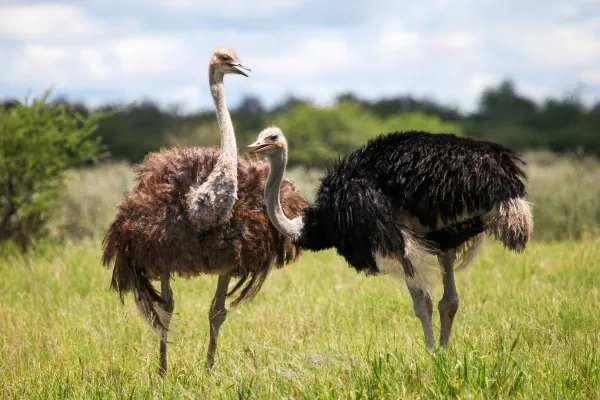
Size & speed: males 2.5–2.8 m tall; 100–145 kg typical; top running speed about 64 km/h, with strides approaching 5 m.
Build: extremely long neck, powerful hind legs with bare lower limbs; body covered in plumage.
Two toes per foot (the outer toe is reduced)—unusual among birds—improves high-speed running and shock absorption.
Sexual dimorphism: males mostly black with white wing and tail plumes; females brown-gray for camouflage.
Thermal control & stability: wings aid balance/steering while running; feather postures help heat loss or retention; relatively water-efficient.
Defense & behavior: when threatened they crouch to blend in or outrun danger; close-quarters kicks can be powerful and dangerous.
Vision: among the largest eyes of any land vertebrate—excellent long-range detection on open plains.
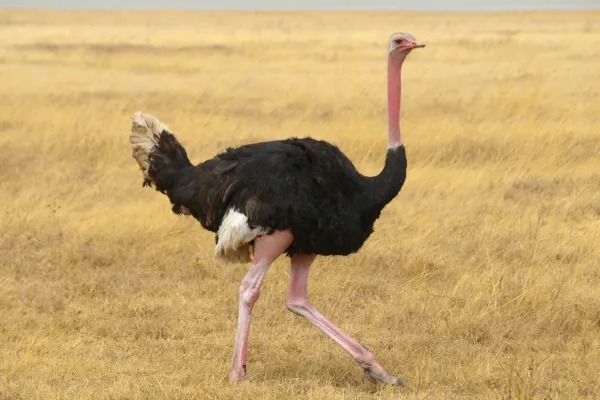
Within genus Struthio, two living species are widely recognized:
Common Ostrich (Struthio camelus) — with several geographic forms (neck/plumage tone varies).
Somali Ostrich (Struthio molybdophanes) — distinctive bluish-gray bare skin on neck and legs; native to the Horn of Africa.
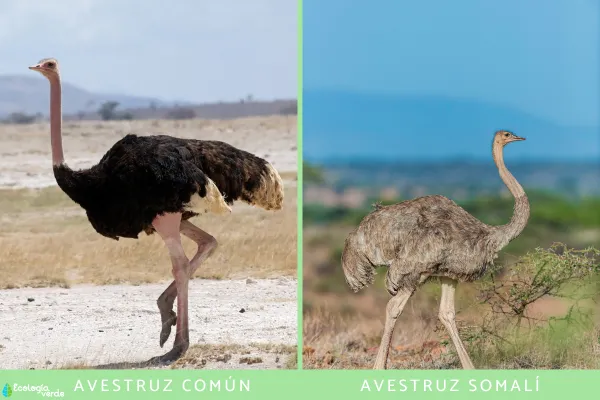
Historically, ostriches occurred farther into North Africa and parts of Southwest Asia; many of those populations have declined or disappeared.
Core range: African savannas, semi-deserts, shrub steppe, and open plains—habitats with broad sightlines to spot predators (lions, leopards, hyenas) early.
Grouping & movement: outside the breeding season, ostriches often form small or loose groups, sometimes traveling with zebras, wildebeest, and other large grazers. These “ecosystem engineers” churn soil and flush insects, benefiting ostriches with food access and shared vigilance.
Range change: former populations in Arabia/West Asia have mostly vanished due to hunting and land-use change.
Primarily herbivorous: grasses, seeds, young leaves, buds, fruits.
Opportunistic omnivory: small amounts of insects, small reptiles, or carrion.
No teeth: rely on a muscular gizzard; swallow gastroliths (pebbles) to grind tough fibers and seed coats.
Water economy: obtain significant moisture from plants and metabolic water, supporting drought tolerance and long intervals without drinking.
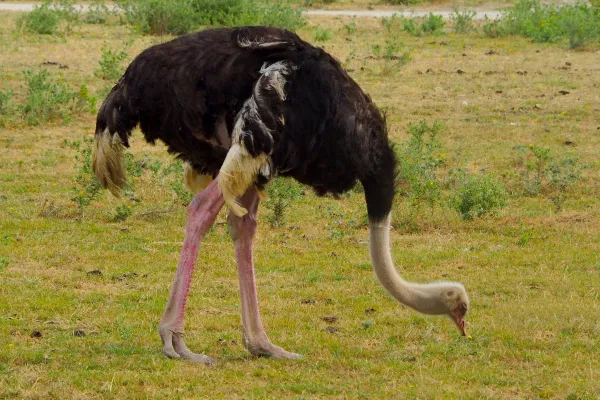
Maturity: ~2–4 years (females usually mature a bit earlier).
Breeding system: territorial males perform dramatic courtship displays and may mate with multiple females.
Nest: the male scrapes a shallow ground bowl used as a communal nest.
A single female lays ~7–10 eggs; a communal nest may hold 20–50+ eggs.
Incubation: ~39–42 days; females by day, male by night (dark plumage camouflages him at night).
Chicks: fast-growing, but early survival depends strongly on predation pressure, weather, and habitat quality.
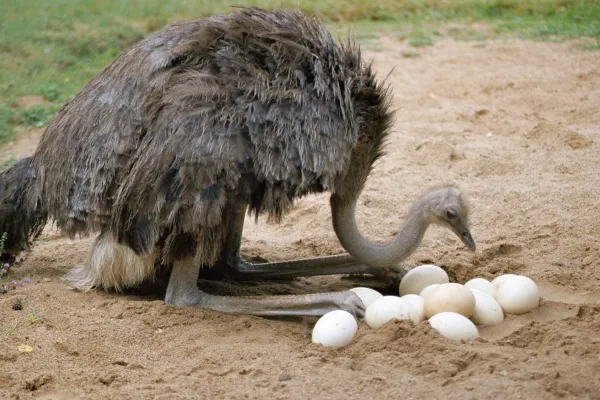
Habitat loss/fragmentation from agriculture, roads, and settlement reduces continuous open grassland.
Hunting and exploitation for meat, leather, and feathers depress local wild numbers.
Climate change alters rainfall regimes, affecting plant productivity and water availability.
High egg/chick predation (jackals, foxes, raptors) plus human disturbance lowers reproductive success.
What helps: protecting savanna landscapes, supporting community-managed rangelands, avoiding illicit wild-sourced feather/skin products, and backing sustainable ranching that reduces pressure on wild birds.
Largest bird egg today: one ostrich egg ≈ ~24 chicken eggs by volume.
“Head in the sand” myth: ostriches do not bury their heads; they crouch to reduce their profile and may lower heads to tend eggs.
Eyes: exceptionally large eyes enable early predator detection across open terrain.
Use by humans: ostrich feathers and leather have been utilized for millennia in North Africa and the Middle East; modern regulated farming is distinct from wild poaching.
Safety: breeding males can be aggressive; maintain professional handling and visitor distances in farms and reserves.
Scientific names: Struthio camelus (Common), Struthio molybdophanes (Somali)
Height (♂): 2.5–2.8 m
Mass (♂): 100–145 kg typical
Top speed: ~64 km/h
Toes: two per foot (cursorial adaptation)
Diet: plant-based, with minor animal matter
Nest: ground scrape; often communal
Incubation: ~39–42 days
Range: African savannas, semi-arid plains, shrublands
Bibliografía
Animal Diversity Web. (2024). Struthio camelus (common ostrich). University of Michigan Museum of Zoology. https://animaldiversity.org/accounts/Struthio_camelus/
Kenya Wild Parks. (2023). Fun facts about the ostrich. https://www.kenyawildparks.com/fun-facts-about-the-ostrich/
PBS Nature. (2023). Ostrich fact sheet. https://www.pbs.org/wnet/nature/blog/ostrich-fact-sheet/
PubMed. (2002). Ostrich communal nesting and egg selection. https://pubmed.ncbi.nlm.nih.gov/12492891/
World Animal Protection. (2024). Ostrich facts and welfare concerns. https://www.worldanimalprotection.org/latest/blogs/ostrich-facts/
animal tags: ostriches
We created this article in conjunction with AI technology, then made sure it was fact-checked and edited by a Animals Top editor.